| |
| About Egypt | Cities Attraction |
|
|
|
The major attractions in Egypt are Cairo, Alexandria and the northern coast, Nile cruises, Luxor, Abu Simbel, Aswan and the Pharaonic treasures, the Sinai peninsula, and the fabulous Red Sea coastline. Egypt’s combination of beach resorts and ancient heritage make it one of the most exciting holiday centres within easy reach of Europe.
|
|
|
|
|
|
|
| |
|
| |
|
|
|
|
|
|
| |
|
 |
|
| |
The capital is a city of astonishing diversity and vitality, uniting elements of Africa, the Orient and Western Europe. Sprawling around the Nile and up towards the Delta, Cairo has a population of 14 million and needs several days to visit properly.
Helwan, a famous winter resort and health spa, is 30km (18 miles) from Cairo. At nearby Sakkara, the step pyramids of Zoser are even older than those at Giza and there are fine wall reliefs, particularly in the Necropolis. Donkey rides can be taken to Sakkara from Giza. 50km (30 miles) further south is Al Faiyoum, a salt-water lake visited by Herodotus in 450BC (malaria is a serious risk here). |
|
| |
 |
|
|
|
|
|
|
| |
|
 |
|
|
Travel House offer Nile cruises, the majority operating from Luxor to Aswan or vice versa. There are numerous cruise steamers on the Nile, and the majority operate to a very high standard of service. According to the particular vessel used they carry from between 50 to 100 passengers, with the facilities varying according to size of the individual vessel. Contacting Travel House specialist operator is recommended for choosing a Nile cruise. |
|
|
|
|
|
|
|
|
|
|
Alexandria is more modern than Cairo but is graced by numerous Hellenistic and Roman relics from the age when it was the cultural capital of Europe. It remains a popular holiday resort for Egyptians.
The northern beaches stretch from the Libyan border to the Nile Delta and along the north of Sinai. West of Alexandria, the coast road takes one to the Mersa Matruh resort, which has a very fine beach; from there it is possible to head inland to visit the Siwa Oasis (site of Amun’s oracle, visited by Herodotus and Alexander the Great) on the Libyan border. There are other fine beaches at El Alamein (where World War II relics are on view), Baltim, Gamasa, Sidi Kreir and Ras El Bar, where the temperatures are warm enough for bathing until November. |
|
|
|
|
|
|
|
|
 |
|
|
Luxor – Homer’s ‘Hundred-gated Thebes’ – is about 500km (300 miles) south of Cairo and contains a vast conglomeration of ancient monuments: the Temples of Amon at Karnak; colossal statues, obelisks and halls (there is, as at Giza, a son et lumière show); the Valley of the Queens and the Valley of the Kings, where 64 of the Pharaohs are depicted in an enormous relief hewn from the rock. The other temples, tombs and monuments are equally awe-inspiring. Since 1988 visitors have had the opportunity to view these monuments from a hot-air balloon. Many specialist guidebooks are available; the Egyptian State Tourist Office will also be able to supply more detailed information. |
|
|
|
|
|
|
|
|
 |
|
|
As well as being a beautiful winter resort with many hotels, Aswan has a huge array of temples, monasteries, the Elephantine Island’s ancient Nilometre, and the Aswan High Dam, one of the three largest dams in the world. 2km (1.2 miles) south of Aswan is Philae, a classical temple considered to be sufficiently important to be saved from the flooding caused by the opening of the Dam. Further to the south is Abu Simbel – surviving largely thanks to a UNESCO-backed project in the 1960s – with the two magnificent temples of Rameses II. 120km (75 miles) north of Aswan is the temple of Edfu, one of the best preserved in Egypt. There are three weekly sailings from Aswan down the Nile into the Sudan. |
|
|
|
|
|
|
|
|
 |
|
|
Sinai’s diving resorts include Ras Mohammed, Sharm el-Sheikh, Dahab, Neweiba and Arish, most with diving centres offering lessons at all levels. The views across the Gulf of Aqaba to the Saudi Mountains are breathtaking and temperatures are warm until very late in the year. Other watersports are on offer and the whole Sinai east coast has beach resorts with hotels and beach huts where the desert merges into beach fringed by palm trees. Ras Mohammed, the southernmost point of the peninsula, is the site of the world’s most northerly mangrove forest.
In the interior there are the rugged and scenic Sinai Mountains, amongst which is the Mount Sinai of the Bible. Nearby is the famous St Catherine’s Monastery. This was first settled by hermits in the 4th century and attracted an increasing number of pilgrims, particularly after the construction of a sanctuary in 337. Almost every subsequent century saw additions to the architecture of the settlement, as well as intermittent periods of decline and abandonment. Many of the bequests made to the monastery over the years are also on display in the museum. Other attractions in Sinai include Saladin’s massive Qalaat al-Gundi fortress, one of the region’s many reminders of the Crusaders’ presence in the Middle East during the 12th and 13th centuries; and Al-Tur, on the Red Sea, capital of South Sinai.
The newest tourist attraction in Egypt is perhaps the western coast of the Red Sea. Hurghada, some 400km (250 miles) south of Suez, is a well-equipped diving resort with marvellous coral reefs. There is a modern tourist village at El Gufton nearby. |
|
 |
|
|
|
| |
|
|
|